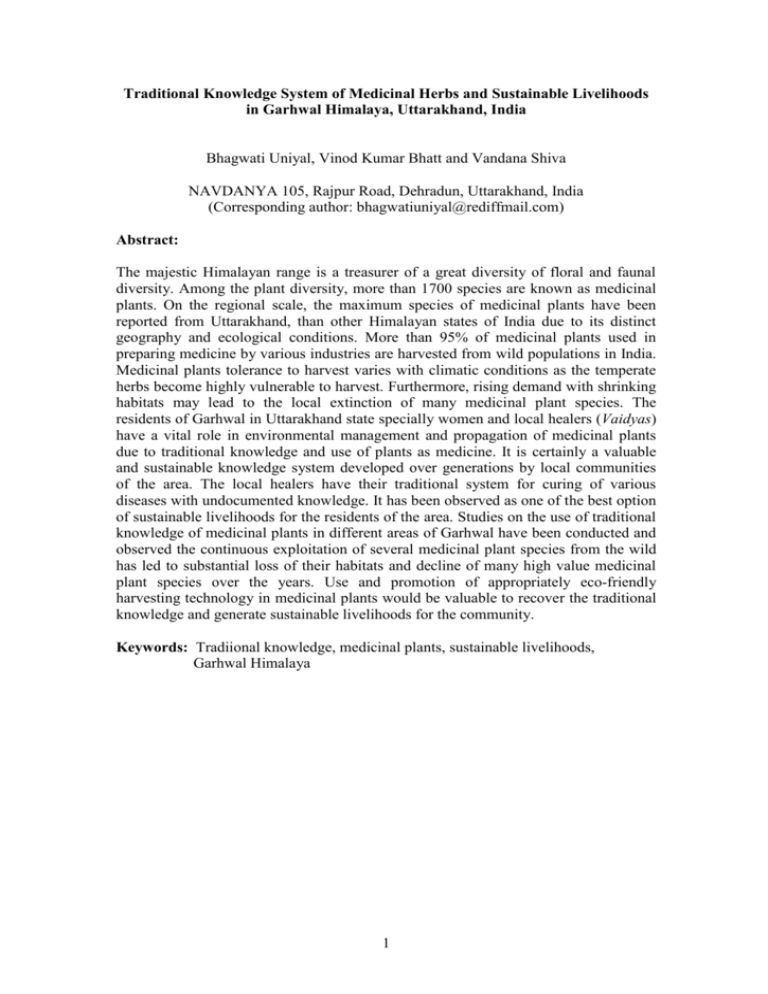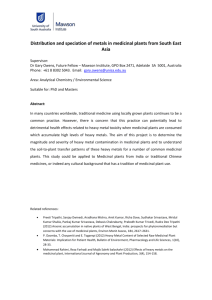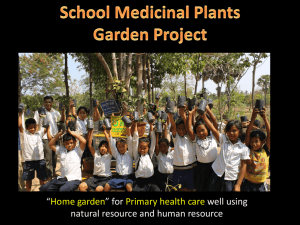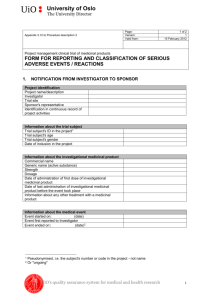Traditional Knowledge System of Medicinal Herbs and Sustainable
advertisement

Traditional Knowledge System of Medicinal Herbs and Sustainable Livelihoods in Garhwal Himalaya, Uttarakhand, India Bhagwati Uniyal, Vinod Kumar Bhatt and Vandana Shiva NAVDANYA 105, Rajpur Road, Dehradun, Uttarakhand, India (Corresponding author: bhagwatiuniyal@rediffmail.com) Abstract: The majestic Himalayan range is a treasurer of a great diversity of floral and faunal diversity. Among the plant diversity, more than 1700 species are known as medicinal plants. On the regional scale, the maximum species of medicinal plants have been reported from Uttarakhand, than other Himalayan states of India due to its distinct geography and ecological conditions. More than 95% of medicinal plants used in preparing medicine by various industries are harvested from wild populations in India. Medicinal plants tolerance to harvest varies with climatic conditions as the temperate herbs become highly vulnerable to harvest. Furthermore, rising demand with shrinking habitats may lead to the local extinction of many medicinal plant species. The residents of Garhwal in Uttarakhand state specially women and local healers (Vaidyas) have a vital role in environmental management and propagation of medicinal plants due to traditional knowledge and use of plants as medicine. It is certainly a valuable and sustainable knowledge system developed over generations by local communities of the area. The local healers have their traditional system for curing of various diseases with undocumented knowledge. It has been observed as one of the best option of sustainable livelihoods for the residents of the area. Studies on the use of traditional knowledge of medicinal plants in different areas of Garhwal have been conducted and observed the continuous exploitation of several medicinal plant species from the wild has led to substantial loss of their habitats and decline of many high value medicinal plant species over the years. Use and promotion of appropriately eco-friendly harvesting technology in medicinal plants would be valuable to recover the traditional knowledge and generate sustainable livelihoods for the community. Keywords: Tradiional knowledge, medicinal plants, sustainable livelihoods, Garhwal Himalaya 1 Introduction The use of medicinal plants has always been a part of human heritage. Traditional medical knowledge has been defined as the sum of the knowledge, skills and practices based on the theories, beliefs and experiences indigenous to different culture, whether explicable or not, used in the maintenance of health as well in the prevention, diagnosis, improvement or treatment of physical and mental illness. Over the centuries, various ethnic communities have developed their own indigenous knowledge in recognizing, harvesting and using plants to cure different ailments. In many developing countries, a large part of the population, especially in rural areas, depends mainly on traditional medicine for their primary health care. In India, about 65% population depends on the traditional system of medicine (Timmermans, 2003). Plants have traditionally served as man’s most important weapons against pathogen. Medicinal plants are widely used by all section of the community, whether directly as folk remedies or the medicaments of the different indigenous system as well as in modern medicine (Alok 1991, Kala et al. 2004). The various forest types in the Himalayan region of India are the repository of diverse flora and many of these species posses high medicinal properties. People living in the rural areas are mainly associated with the forest life to fulfill their daily needs for fuel, fodder and other forest produce. Since the time of Great saga Charak, the traditional knowledge on medicinal plants has led to the discovery of many important drug of modern age (Uniyal et al. 2002). The Himalaya has played a very important role in the advancement of many such herbal drugs and still the utilization as medicinal plants is very high with the Himalayan people. Economically weaker sections of the community collect medicinal plants from the forests for commercial use as livelihood option which is a cause of concern to the conservation biologists. The healers residing in the rural areas of the Himalaya play a vital role in knowing the medicinal properties of the various plant species hence, their knowledge must be considered as an essential component for the development of the rural areas. Failure to document this indigenous knowledge would represent a tremendous economic and scientific loss to mankind (Uniyal, 2003, 2004; Uniyal and Shiva 2005). The main purpose of the study is to document the indigenous knowledge of local healers and 2 suggests appropriate conservation practices for the rural areas of Garhwal region of Uttarakhand state. Uttarakhand is known as green state among other Himalayan states of India. Approximately 70% of the state comprises natural forest and rangelands. Most people reside in rural areas and live off small scale agriculture. Road and transport is not well developed because of the hilly terrain and remoteness of communities. The people of the state have a strong tradition of protecting the environment and biodiversity. Medicinal plants are an integral part of the life of the residents of the state, due to its diverse topographical and climatical condition, the region harbours a variety of medicinal plant species. A large number of medicinal plants have been used in traditional system of medicine which is found in different habitats and ecosystems. There are about 2, 50,000 higher plant species distributed throughout the world. Of these 17,000 species of higher plants are found in India of which, 7500 species are used in the Indian traditional system of medicine (Shiva, 1996). Broadly these medicinal plant species can be classified into different categories viz. trees, herbs, shrubs, creepers and grasses. Different parts of these plants: leaf, stem, bark, root, tuber, flower, fruit, seeds, etc. have been used for curing different disease. The Himalaya is the treasure of many important medicinal and aromatic plants; the uses of these medicinal plant species have been documented in many of the old Hindu scriptures such as Rigveda, a main source of the ancient medicine system of Ayurveda. Indian Himalaya harbours 8000 species of angiosperms, 44 species of gymnosperms and 600 species of pteridophytes. Of which, 1748 species are known as medicinal plants and maximum species have been reported around up to 1800 m altitudinal range (Singh and Hajra, 1996; Kala et al. 2006). Increased developmental activities and commercial exploitation of the natural resources has led to the depletion of many important medicinal plant species raising concern among the various sections of the society (Uniyal and Shiva, 2005). In Garhwal Himalaya, majority of herb collectors are not trained. They collect the premature plant species from the natural habitats for selling to any prospective buyers. This is affecting the population and regeneration of medicinal plants in the wild. Many species of medicinal value are now at the brink of extinction and most of them have been declared as threatened, rare, vulnerable or endangered species depending on the available frequency in nature. 3 Traditional Local Healers Bhotia Women of the StudyArea 4 The aim of the study was to document the significance of indigenous knowledge and sustainable development and conservation through people’s participation (mainly women) in the Himalayan region of Garhwal. Study Area The study was conducted in the area located at Latitude N3008’- 31 02’ and Longitude E 79 12’- 80 19’ with large altitudinal range 1800 to 3500 amsl in Chamoli district of Garhwal region which have unique topography, climate and soil supporting diverse ecosystem, habitats, communities, richness and floral and faunal species. The high percentages of endemic species richness itself identify the conservation value of the area. The area supports over 1,000 species of plants including bryophytes, fungi and lichens. The community resides in this area belongs to the Indo-Mongoloid (Bhotia) and Indo-Aryan tribal groups. Survey was conducted in eight different villages of high altitude areas in Joshimath tehsil of Chamoli district of Garhwal (Fig.1). Local healers and resource persons mainly women, using medicinal plants for curing of various diseases were interviewed for documenting the information. To develop a data base on medicinal plants, all possible information has been collected after conducting extensive field visits in the area. Study villages were selected according altitudinal gradients (2000-3400 m) and habitat specification as to cover maximum information to achieve the goal (Table 1). Table- 1. Study Area villages District Chamoli Tehsil Villages Altitude (M) Habitat Reni Lata Peng 2200 2300 2350 Temperate mixed forest Temperate mixed forest Temperate mixed forest Tolma Malari 2680 3100 Temperate mixed forest Sub alpine Bumpa 3300 Sub alpine Gamshali 3300 Alpine Niti 3400 Alpine Joshimath 5 Faran (Allium stracheyi) Kirmod (Berberis asiatica) Collection and Traditional Processing of Drying Medicinal Plants Malari Village Niti Village Study Area Landscape 6 Fig. 1- Map of Study Area Surveyed Methodology Adopted Documentation of Medicinal Plants and Indigenous Knowledge Following methods were adopted to document and to generate relevant information on the indigenous knowledge of medicinal plants in the study area. i. Questionnaire Survey: Taxonomic and ethnobotanical information was generated with the help of questionnaire. Local healers of the area are mainly women, they were interviewed; their methods for curing of various diseases, area of collection of medicinal plants, preparing the cultivation practices and present demand was recorded. ii. Participatory Research Method: In additional to questionnaire survey, participatory research method was used to document the information on all aspects of medicinal plants including conservation practices adopted by the 7 community. Group meetings were conducted in the villages with the women, local healers and other resource persons. Results During the survey conducted (October 2008-September 2009) eight villages of high altitude areas of Chamoli district of Garhwal has been surveyed and documented the use of prominent medicinal plants collected by the healers for curing various diseases for the community. Some of the plant species were marketed by the local people for income generation. The collection was done from the forest areas near village surrounds and alpine pastures. Detailed information about the medicinal plants, their properties, area of collection, ethnomedicine uses have been provided: 1. Botanical name Family Local name Altitude Habitat Collection stage Season of Collection Disease pattern Plant part used Nature of plant part used Mode of preparation : : : : : : : : : : : Picrorhiza kurrooa r Scrophulariaceae Kadu 2500 -3500 m amsl Moist rocky slopes Vegetative (Roots) Sept-Oct Roots are used for stomachache and fever Root Dried Powder 2. Botanical name Family Local name Altitude Habitat Collection stage Season of collection Disease pattern : : : : : : : : Plant part used Nature of plant part used Mode of preparation : : : Aconitum heterophyllum Ranunculaceae Atees 3000-3500 m amsl Grassland Vegetative (Roots) Sept-Oct Roots are used of fever, rheumatism and stomachache Root Dried Powder 8 (1) Kutki (Picrorhiza kurrooa) (2) Atees (Aconitum heterophyllum) (3) Ban Kakadi (Podophyllum hexandrum) (4) Mahamaida (Polygonatum verticillatum) (5) Dolu (Rheum austral) (6) Faran (Allium stracheyi) (7) Choru (Angelica glauca) (8) Pashan Bhed (Bergenia ciliate) (9) Ban Tulsi (Origanum vulgare) (10) Chirayata (Swertia chirayata) (11) Burans (Rhododendron arboretum) (12) Kirmod (Berberis asiatica) 9 (13) Dhoop Lakkad (Jurinea dolomiaea) (14) Dalchini (Cinnamomum tamala) (15) Jatamansi (Nardostachys grandiflora) (16) Hath Panja (Dactylorhiza hatagirea) 10 3. Botanical name Family Local name Altitude Habitat Collection stage Season of collection Disease pattern Plant part used Nature of plant part used Mode of preparation : : : : : : : : : : : Podophyllum hexandrum Podophyllaceae Ban kakari 2200 -3000 m amsl Forest Vegetative (Roots) June-July Roots are used in the treatment of septic wounds Roots Dried Powder 4. Botanical name Family Local name Altitude Habitat Collection stage Season of Collection Disease pattern Plant part used Nature of plant part used Mode of preparation : : : : : : : : : : : Polygonatum verticillatum Liliaceae Maha maida 2200 – 2700 m amsl Forest Vegetative (Roots) Aug-Sep Used in the urinary problems Roots Dried Powder 5. Botanical name Family Local name Altitude Habitat Collection stage Season of collection Disease pattern : : : : : : : : Plant part used Nature of plant part used Mode of preparation : : : Rheum australe Polygonaceae Dolu 3000 -3400 m amsl Moist bouldery slopes Vegetative (Roots) July- Aug Treatment of internal injuries, bone fracture, indigestion, general weakness Roots Dried/Fresh Paste 6. Botanical name Family Local name Altitude Habitat Season of collection Disease pattern Plant part used : : : : : : : : Allium stracheyi Amaryllidaceae Faran 2500-3000 m amsl Moist bouldery slopes and alpine pasture July- Aug Used in indigestion and spices Entire plant 11 Nature of plant part used : Use of medicine in the form of: Mode of preparation : Dried/Fresh Dried plant Threshed pieces 7. Botanical name Family Local name Altitude Habitat Collection stage Season of Collection Disease pattern Plant part used Nature of plant part used Mode of preparation : : : : : : : : : : : Angelica glauca Apiaceae Choru 2500-3000 m amsl Cool temperate, sub-alpine forests Roots Sept-Oct Roots used in the cure of stomach disorders Roots Dried Powder 8. Botanical name Family Local name Altitude Habitat Collection stage Season of collection Disease pattern : : : : : : : : Plant part used Nature of plant part used Mode of preparation : : : Bergenia ciliata Saxifragaceae Silpharu 1500-2000 m amsl Moist rooky slopes Rhizome Sept-Oct Rhizome used in the cure of kidney stone and internal wounds Rhizome Dried Powder 9. Botanical name Family Local name Altitude Habitat Collection stage Sampling technique Season of collection Disease pattern : : : : : : : : : Plant part used Nature of plant part used Mode of preparation : : : Origanum vulgare Lamiaceae Ban Tulsi 3000 - 3400 m amsl Sub-alpine forests to Alpine meadows Leaves Bulk July-Aug Leaves are used toothache and swelling, making tea Leaves Fresh/Dried Others (leaves and inflorescence) 12 10. Botanical name Family name Local Altitude Habitat Collection stage Sampling technique Season of collection Disease pattern Plant part used Nature of plant part used Mode of preparation : : : : : : : : : : : : Swertia chirayata Gentianaceae Chirayata 2000 -2700 m amsl Moist temperate forests Leaves Selective July-Aug Leaves are used in blood disease Leaves Fresh/Dried Powder 11. Botanical name Family Local name Altitude Habitat Collection stage Season of collection Disease pattern : : : : : : : : Plant part used Nature of plant part used Mode of preparation : : : Rhododendron arboreum Ericaceae Burans 2000-2700 m amsl Moist temperate forests Flowers March-April Flower juice is used in headache and blood dysentery Flowers Fresh Decoction 12. Botanical name Family Local name Altitude Habitat Collection stage Season of Collection Disease pattern : : : : : : : : Plant part used Nature of plant part used Mode of preparation : : : Berberis asiatica Berberidaceae Kingor 1500-2500 m amsl Open forest Roots March-April Roots are used to cure of ulcer, jaundice and fever Roots Dried Powder 13. Botanical name Family Local name Altitude Habitat : : : : : Jurinea dolomiaea Asteraceae Dhoop 2600-3300 m amsl Alpine meadows 13 Collection stage Season of Collection Disease Pattern : : : Plant part used Nature of plant part used Mode of preparation : : : Roots Sept - Oct Roots are extracted for making incense and used in fever Roots Dried Powder 14. Botanical name Family Local name Altitude Habitat Collection stage Season of collection Disease pattern Plant part used Nature of plant part used Mode of preparation : : : : : : : : : : : Cinnamomum tamala Lauraceae Dalchini 1500-2500 m amsl Temperate Forest Leaves April-May Leaves are used in Cold, Nausea & Vomiting Leaves Dried/Fresh - 15. Botanical name Family Local name Altitude Habitat Collection stage Season of collection Disease pattern Plant part used Nature of plant part used Mode of preparation : : : : : : : : : : : Nardostachys grandiflora Valerianaceae Mansi 2000-2800 m amsl Shady, Moist Rocks Roots Sept-Oct Roots are highly prized as incense, Heart tonic Roots Dried Powder 16. Botanical name Family Local name Altitude Habitat Collection stage Sampling technique Season of collection Disease pattern Plant part used Nature of plant part used Mode of preparation : : : : : : : : : : : : Dactylorhiza hatagirea Orchidaceae Hathpanja 3000-3500 m amsl Shady, moist area Rhizome Selective Sept - Oct Rhizome are highly prized for stomach pain Rhizome Dried Powder 14 Acknowledgements We are thankful to Indian Council of Medical Research (ICMR) New Delhi for providing financial assistance to conduct the study. Thanks to Dr. Gajendra Singh, (DST, Young Scientist) Wildlife Institute of India, Dehradun for identification of medicinal plants. References Alok, S.K, 1991.Medicinal plants in India: Approaches to Exploitation and Conservation. The Conservation of Medicinal Plants. Cambridge University Press: 295-303. Kala, C.P., N. Farooquee and U. Dhar. 2004. Prioritization of medicinal plants on the basis of available knowledge, existing practices and use value status in Uttaranchal, India. Biodiversity and Conservation 13: 453-469. Kala, C.P.; P.P. Dhyani and B.S. Sajwan. 2006. Developing the medicinal plants sector in northern India: challenges and opportunities: Journal of Ethnobiology and Ethnomedicine: 2-23. Shiva, M.P. 1996. Inventory of Forestry Resources for sustainable Management andf Biodiversity Conservation. New Delhi: Indus Publishing Company. Singh, D.K. and P.K. Hajra. 1996. Floristic diversity. In biodiversity status in the Himalaya. New Delhi: British Council: 23-38. Timmermans, K. 2003. Intellectual property rights and traditional medicine: policy. Uniyal Bhagwati. 2004. Indian Barberry in Himalayan wastelands. Natural Product Radiance, National Institute of Science Communication, CSIR, New Delhi.Vol. 3, pp.87. Uniyal, Bhagwati and Vandana Shiva. 2005. Traditional knowledge on medicinal plants among rural women of the Garhwal Himalaya, Uttaranchal. Indian Journal of Traditional Knowledge, Vo. 4(3) 259-266. Uniyal, Bhagwati, 2003. Utilization of Medicinal plants by the rural women of Kullu Himachal. Indian Journal of Traditional Knowledge, Vo. 2(4) 366-370. Uniyal, S. K., A. Awasthi and G.S Rawat. 2002. Traditional and ethnobotanical uses of plants in Bhagirathi Valley (Western Himalaya), Indian Journal of Traditional Knowledge, Vol. 1 (1): 7-19. -------------------------------- 15






